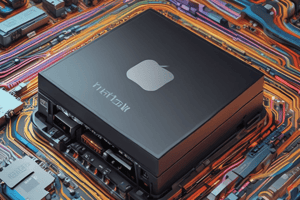Podcast
Questions and Answers
What is one of the main reasons for using a Local Area Network (LAN)?
What is one of the main reasons for using a Local Area Network (LAN)?
- To limit information sharing capabilities
- To have dedicated servers for each user
- To reduce data duplication and inconsistency (correct)
- To decrease resource sharing among users
In a Peer-to-peer network, how do computers typically function?
In a Peer-to-peer network, how do computers typically function?
- As dedicated servers for specific tasks
- Acting as both clients and servers (correct)
- Acting only as clients that request information
- Having no interaction with servers
What is a characteristic of a Dedicated server network?
What is a characteristic of a Dedicated server network?
- Servers are permanently assigned a specific task (correct)
- No specific tasks are assigned to servers
- Less popular than other network types
- It is cheaper than a Peer-to-peer network
Which basic LAN component delivers information or provides services to clients?
Which basic LAN component delivers information or provides services to clients?
How does a LAN contribute to improved decision making?
How does a LAN contribute to improved decision making?
What is the purpose of a NIC in a network?
What is the purpose of a NIC in a network?
Which type of cable is not flexible and is considered heavy?
Which type of cable is not flexible and is considered heavy?
What does a hub primarily do in a network?
What does a hub primarily do in a network?
What does a network operating system (NOS) replace on a server?
What does a network operating system (NOS) replace on a server?
What is the main role of the Client Software in a Network Operating System?
What is the main role of the Client Software in a Network Operating System?
Which protocol does the NOS Directory Service use to interact with client computers?
Which protocol does the NOS Directory Service use to interact with client computers?
What is the function of Active Directory Service (ADS) in a LAN?
What is the function of Active Directory Service (ADS) in a LAN?
Flashcards are hidden until you start studying
Study Notes
Local Area Network (LAN)
- One of the main reasons for using a LAN is to enable resource sharing and improve communication among devices.
Network Architecture
- In a Peer-to-peer network, computers typically function as both clients and servers, sharing resources without a central authority.
- A Dedicated server network is characterized by a central server that manages resources and provides services to client computers.
LAN Components
- A server is a basic LAN component that delivers information or provides services to clients.
- A Network Interface Card (NIC) is installed in a computer to connect it to a network and enable communication.
LAN Benefits
- A LAN contributes to improved decision making by providing access to shared resources, facilitating collaboration, and enhancing data sharing.
Network Hardware
- A hub is a network device that primarily connects multiple devices together, repeating incoming data signals to all connected devices.
- Coaxial cable is not flexible and is considered heavy, often used in older networks.
Network Operating System (NOS)
- A NOS replaces the operating system on a server, managing network resources, and providing services to client computers.
- The main role of the Client Software in a Network Operating System is to request and access network resources and services.
Network Services
- The NOS Directory Service uses the Lightweight Directory Access Protocol (LDAP) to interact with client computers.
- The function of Active Directory Service (ADS) in a LAN is to manage and authenticate user identities, computers, and other resources.
Studying That Suits You
Use AI to generate personalized quizzes and flashcards to suit your learning preferences.




